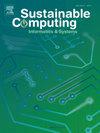智能医疗系统中用于智能决策的物联网和xai驱动的数据聚合框架
IF 5.7
3区 计算机科学
Q1 COMPUTER SCIENCE, HARDWARE & ARCHITECTURE
引用次数: 0
摘要
物联网(IoT)用于医疗保健,通过可穿戴传感器监测患者的不同生理参数。支持物联网的智能医疗传感器和医疗设备数据与其他智能设备协作,以安全的方式将收集到的敏感医疗数据传输到中央服务器。然而,这些收集的数据在实时分析中存在噪声、不平衡、隐私问题和挑战。因此,这项工作是在智能医疗系统中开发一种新的基于物联网和可解释人工智能(XAI)的数据聚合框架,以实现准确的患者健康状况和实时决策。最初,身体集成的可穿戴传感器和设备收集生理数据,形成一个全面的数据集。之后,使用完全同态加密对这些数据进行预处理和加密,以便安全地传输到集中式服务器。使用自动编码器从预处理数据中提取有意义的特征,在保留关键信息的同时进行有效的降维。最后,TabNet对健康状况和风险进行了高精度的分类。TabNet是一个专门为结构化数据设计的深度学习模型,它利用注意机制有效地处理表格数据,进行特征选择和决策。该框架集成了XAI方法,以提供可解释的预测和可操作的见解,确保医疗保健提供者的透明度。结果,TabNet显示出99.57 %的显著准确率,使医生可以随时提供会诊,从而提高了传统医疗系统的效率。本文章由计算机程序翻译,如有差异,请以英文原文为准。
IoT and XAI-driven data aggregation framework for intelligent decision-making in smart healthcare systems
The Internet of Things (IoT) is used in healthcare to monitor patients via wearable sensors to measure different physiological parameters. Smart healthcare IoT-enabled sensors and medical device data collaborate with other smart devices to transfer collected sensitive healthcare data to the central server in a secure manner. However, this collected data suffers from noise, imbalance, privacy concerns, and challenges in real-time analysis. Thus, this work is to develop a novel IoT and Explainable Artificial Intelligence (XAI) based data aggregation framework in smart healthcare systems to enable accurate patient health status and decision-making in real-time. Initially, body-integrated wearable sensors and devices collect physiological data, forming a comprehensive dataset. After that, this data is preprocessed and encrypted using Fully Homomorphic Encryption for secure transmission to the centralized servers. Meaningful features are extracted from the preprocessed data using Autoencoders, which perform effective dimensionality reduction while preserving critical information. Finally, Tabular Network (TabNet) classifies health status and risks with high precision. TabNet is a deep learning model specifically designed for structured data, which efficiently handles tabular data using attention mechanisms for feature selection and decision-making. The framework integrates XAI methods to provide interpretable predictions and actionable insights, ensuring transparency for healthcare providers. As a result, TabNet demonstrates a remarkable accuracy rate of 99.57 %, making it possible for doctors to provide consultations at any time, thereby improving the efficiency of traditional medical systems.
求助全文
通过发布文献求助,成功后即可免费获取论文全文。
去求助
来源期刊

Sustainable Computing-Informatics & Systems
COMPUTER SCIENCE, HARDWARE & ARCHITECTUREC-COMPUTER SCIENCE, INFORMATION SYSTEMS
CiteScore
10.70
自引率
4.40%
发文量
142
期刊介绍:
Sustainable computing is a rapidly expanding research area spanning the fields of computer science and engineering, electrical engineering as well as other engineering disciplines. The aim of Sustainable Computing: Informatics and Systems (SUSCOM) is to publish the myriad research findings related to energy-aware and thermal-aware management of computing resource. Equally important is a spectrum of related research issues such as applications of computing that can have ecological and societal impacts. SUSCOM publishes original and timely research papers and survey articles in current areas of power, energy, temperature, and environment related research areas of current importance to readers. SUSCOM has an editorial board comprising prominent researchers from around the world and selects competitively evaluated peer-reviewed papers.
 求助内容:
求助内容: 应助结果提醒方式:
应助结果提醒方式:


